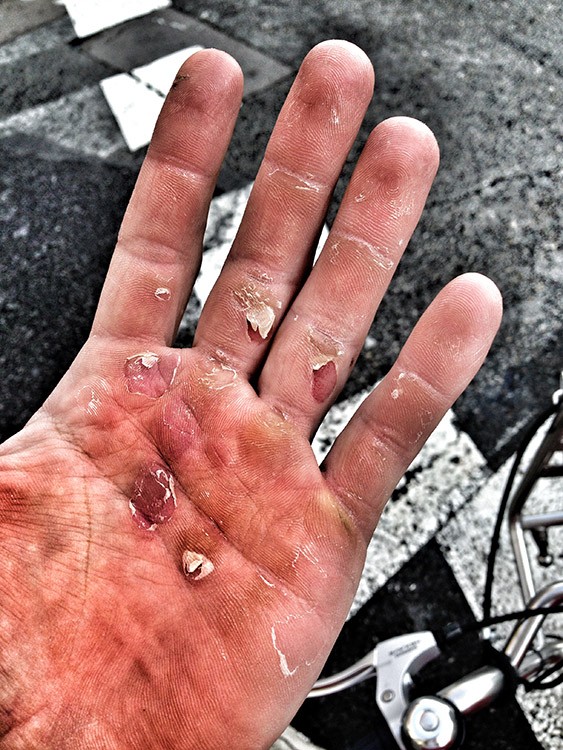Swiss Cheese Hands
Adam Bruce, row2k.com

Well, it is that time of year again; rowers are making their annual pilgrimage to the south for warmer weather and rowable water. After a few months on land, one’s hands may take a bit of a beating on this winter trip. Blisters have always been an annoyance for rowers, but here are few tricks we have found to prevent them and to treat them once they happen. Please note that everything in this article is a suggestion. All questions surrounding any medical issues including blisters should be discussed with your trainer or physician first!
The Dangers
The first question you might ask is “What is a blister?” A blister forms when the outer layer of your skin has been damaged. As a defense mechanism, your body collects a clear fluid called serum underneath the damaged skin. Serum is the part of the blood that remains after clotting agents and red blood cells have been removed. The body uses this fluid to cushion the skin underneath the damaged area to prevent any further injury. (Link)
This is a natural response by the body; however, complications can arise should the blister become infected. If the blister fills with pus and become a milky white color or you see a red streak leading away from the blister, please seek immediate medical attention. All rowers seem to enjoy their high pain tolerance, but a nasty infection could result in a lot of missed practice time and quite a few expensive medical bills. Be sure to clean your oar handles and hands thoroughly everyday to help mitigate your chances of infection from unsanitary surfaces.
Prevention
Step one in preventing blisters is to do what your momma told you: “eat your fruits and vegetables!” Eating foods that contain vitamins A, B5, and C such as apples, carrots, cauliflower, broccoli, and grapefruit can help to speed up the skin’s healing process while resisting infection. (Link)
For a topical solution, some have suggested pretreating your skin with surgical spirit, high-proof rubbing alcohol, or witch hazel. These methods will dry and thicken the skin, it is true; however, your skin may crack as a result, so be careful with this approach. To prevent your skin from cracking or flaking, apply moisturizer containing vitamins A, C, and E. And this may be obvious to some, but do not apply surgical spirit to any open wounds!
Finally, as most coaches will tell you, proper grip will help to protect your hands as well. We can all remember our novice years when we applied a “death grip” to our handle while we rowed. As a result of that grip, our hands will never be the same!
Treatment
There is actually considerable debate on the best way to proceed here. Some sources state that one must leave a blister alone, while others insist a blister must be popped. More than likely if you consult a physician they will tell you to leave your blisters alone and to protect the damaged skin. The problem is anyone, who is willing to traveling on a training trip is not going to go up to their coach and say, “I’m sorry I can no longer row on this trip, I have a blister.” Making the assumption that you will continue to row, here are a few tricks that we have found over the years.
First, you will need to pop the blister; when you do this, it is safest to pop it in a controlled setting, rather than tearing it open during practice. Before I was engrossed in all things rowing, I use to be a gymnast growing up. Blisters and rips were just part of daily life. I can still recall my coach shouting at me “don’t bleed on the mat” when I tore my hand open during practice. Lets try to avoid this out on the water. The following steps were provided by trainers and coaches I have known over the years:
Step 1: Wash your hands with warm water and antibacterial soap for at least 20 seconds.
Step 2: Using a Q-tip or cotton ball, swab the blister with rubbing alcohol or iodine.
Step 3: Sterilize a needle with rubbing alcohol and puncture the blister near its edge. Usually in the opposite direction of the searing force.
Step 4: Cover the blister with antibiotic cream and wrap the area with gauze or a Band-Aid.
Step 5: If possible, wait two or three days and cut away the dead skin with a sterilized pair or scissors. I have also been told applying vitamin E gel caplets to the exposed skin can speed up the healing process. For bloody blisters, apply Betadine. Betadine is a very good antimicrobial that allows you to avoid the pain of using peroxide.
Tea Bags: (Link)
Another blister treatment row2k brought to you a few years ago is the use of tea bags. Placing tea bags over a blister will help in the healing process. Do not wash or wipe your hands after applying the tea bags. The idea is that the tea bag will act as an anesthetic because of the tannic acid in the tea. This will harden the blister, which is particularly helpful when you first pop your blister open. To read the complete article, click on the link above.
MiniHack: Tape Grip
As a coach I see rowers wrap tape all around their hands constantly. The residue from the tape ends up being stuck to their oar and the rower’s hand. When I was growing up, my gymnastics coach showed me how to make a tape grip. A tap grip resolves the issue of traditionally wrapping your hand with tape by covering up the tackiness of the tape while providing a layer of protection between your blister and the oar.
First, fold a piece of athletic tape in half long ways so you have a long skinny piece (see picture). Make this piece approximately 2 to 2.5 hand lengths long. Bring the two ends together and tape along the seam on both sides, leaving enough room at the top for one of your fingers. Slip the hole over your finger that is above the blister and wrap a piece of tape around your wrist. This may not be the best solution for every situation (this will not help if you have a blister on your fingers), but it won’t roll up or stick to you like normal wraps and it is more durable than a Band-Aid.
Do you have any tricks that we haven't mentioned for dealing with blisters? Please comment below!
If you enjoy and rely on row2k, we need your help to be able to keep doing all this. Though row2k sometimes looks like a big, outside-funded operation, it mainly runs on enthusiasm and grit. Help us keep it coming, thank you! Learn more.
Comments | Log in to comment |
- Bont Rowing
- Calm Waters Rowing
- Concept 2
- Craftsbury Sculling
- The Crew Classic
- CrewLAB
- Croker
- Dad Vail Regatta
- Durham Boat Co.
- Empacher
- Faster Masters
- Filippi
- Fluidesign
- h2row.net
- HUDSON
- Live2Row Studios
- Nielsen-Kellerman
- Oak Ridge RA
- Peinert Boat Works
- Pocock Racing Shells
- Race1 USA
- Rockland Rowing Masters Regatta
- RowKraft
- Rubini Jewelers
- Vespoli USA
- WinTech Racing
- Bont Rowing
- Calm Waters Rowing
- Concept 2
- Craftsbury Sculling
- The Crew Classic
- CrewLAB
- Croker
- Dad Vail Regatta
- Durham Boat Co.
- Empacher
- Faster Masters
- Filippi
- Fluidesign
- h2row.net
- HUDSON
- Live2Row Studios
- Nielsen-Kellerman
- Oak Ridge RA
- Peinert Boat Works
- Pocock Racing Shells
- Race1 USA
- Rockland Rowing Masters Regatta
- RowKraft
- Rubini Jewelers
- Vespoli USA
- WinTech Racing


















10/07/2017 12:15:50 AM
A few of us gouged the handle just a bit, dragging a rat tail file along the handle of our preferred oar,then lightly sand it smooth. This added wonderful grip grooves where calluses locked into the right grip. Blister free hands for months. But need to only use that one oar with sweeps.
You can also now buy leather gloves with no seams from wrist to finger tip.
04/18/2017 11:36:27 AM
01/17/2014 3:11:53 PM
01/17/2014 2:34:38 PM
01/16/2014 5:19:38 PM